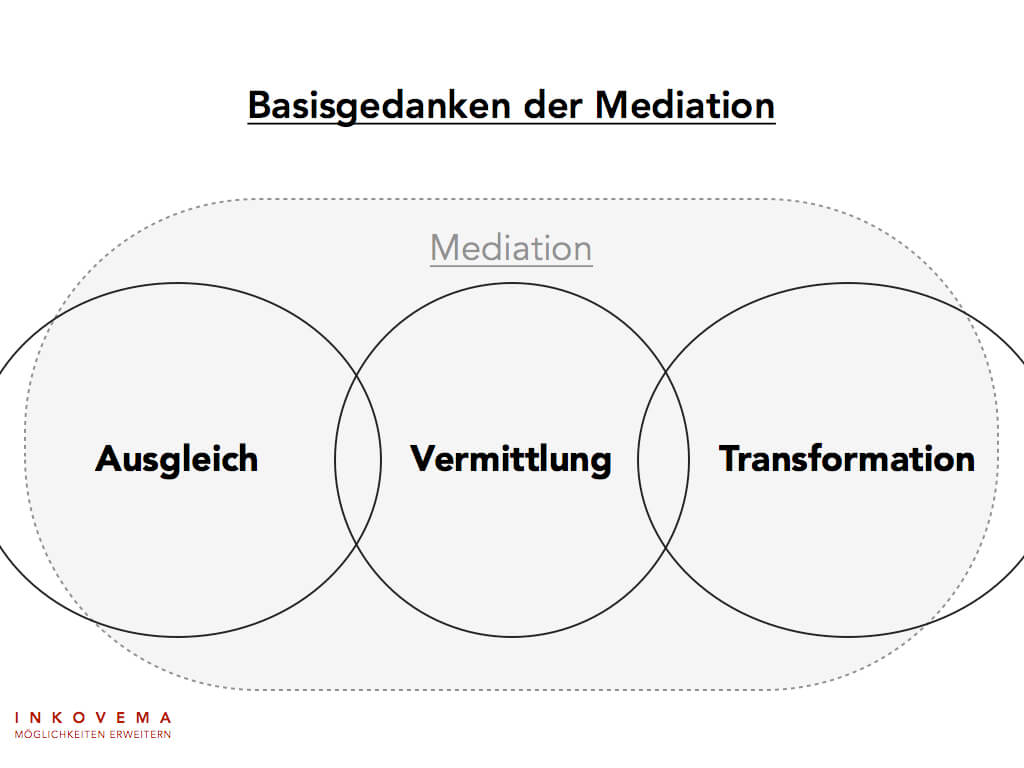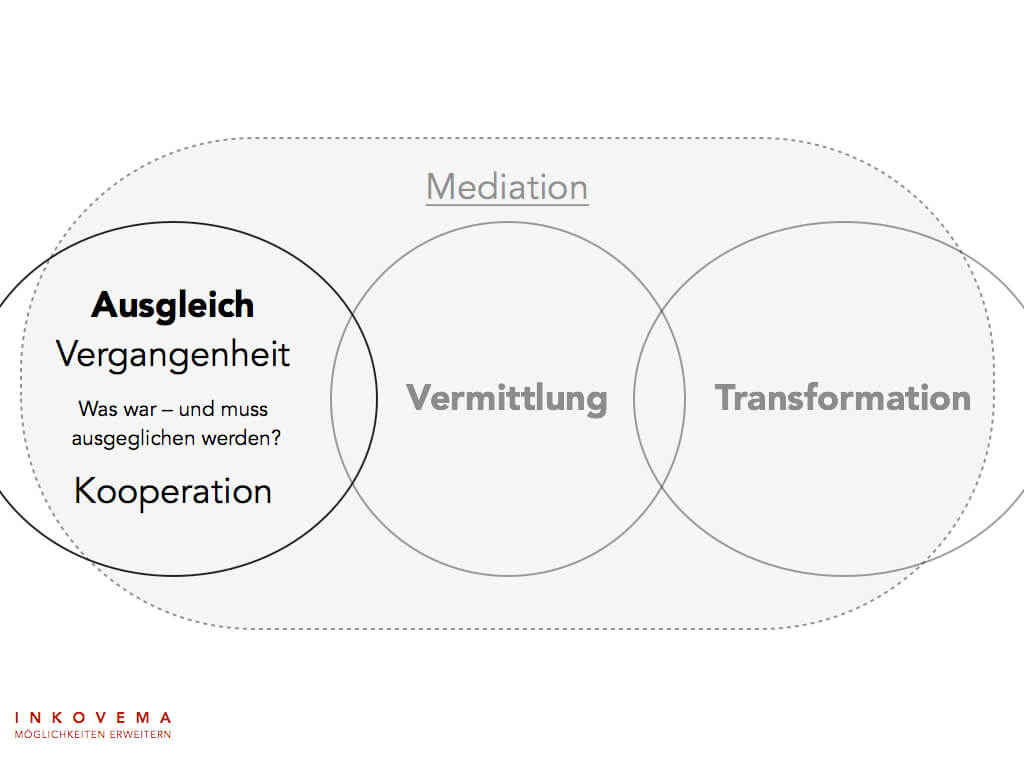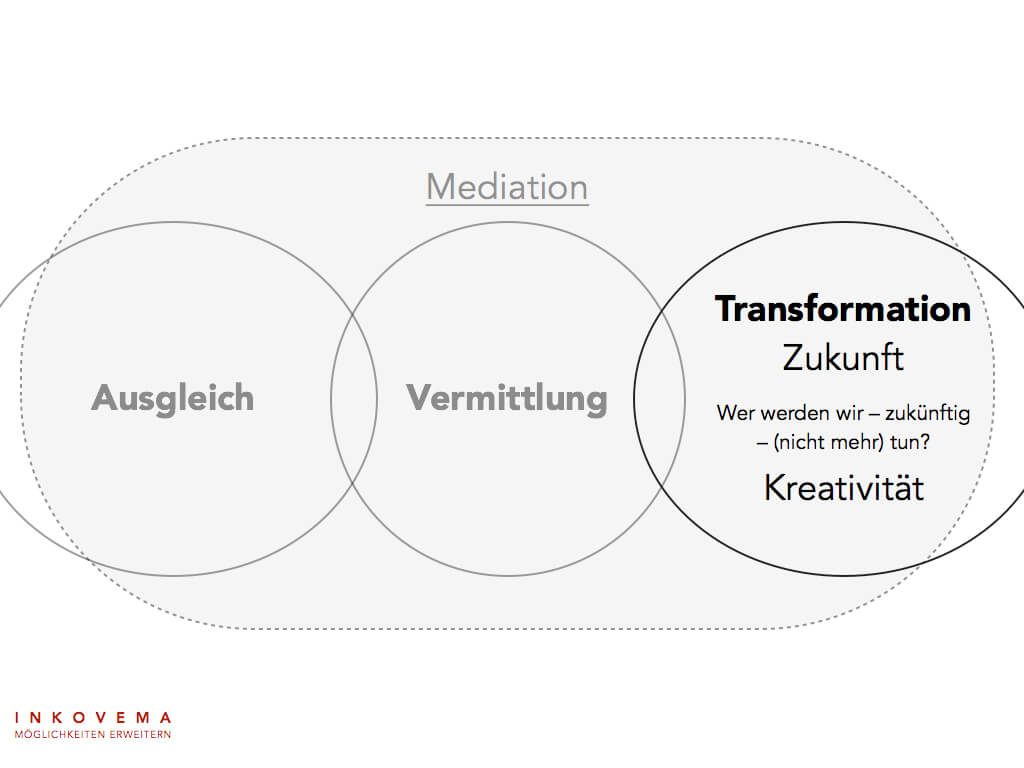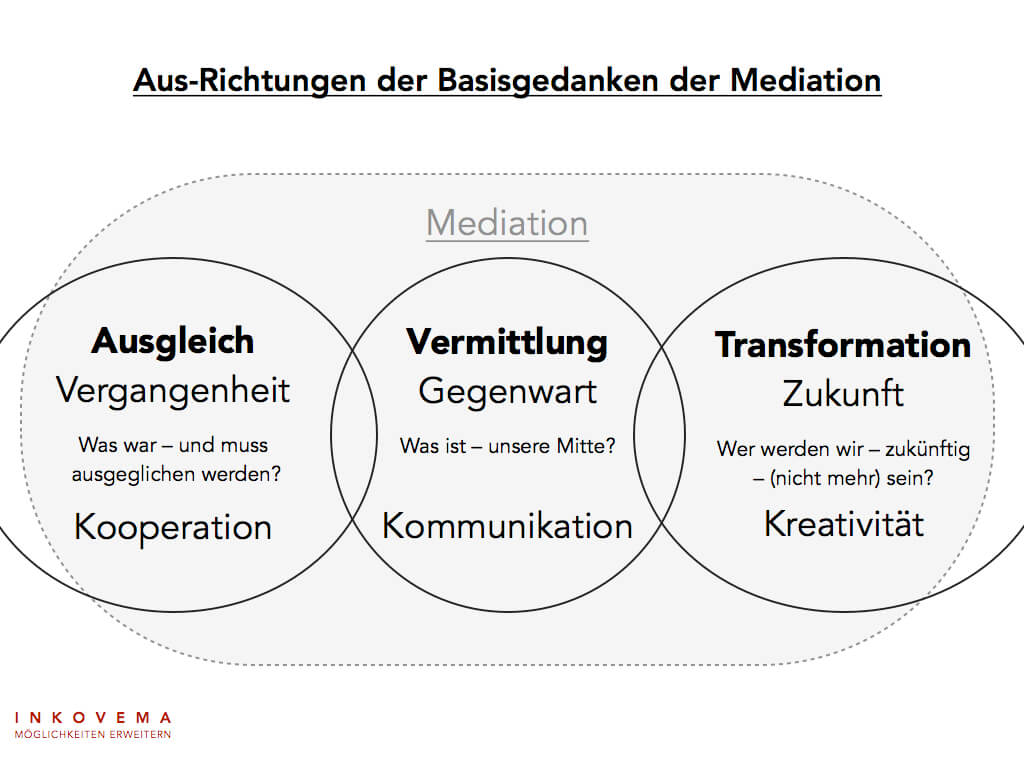What drives mediators: Mediation, equalisation, transformation as guiding principles of mediation
25 Basics of mediation (7)
Listen to the contribution:
Mediators have to come up with something to get those involved in the conflict to let them take part in conflict resolution on their own responsibility!
It's difficult enough as it is, downright unpleasant. Sometimes embarrassing or annoying, but always inconvenient in some way. Who likes to find themselves in conflict? And then a third party comes along who doesn't want to decide anything, but somehow promises to help - for a fee, of course!
The other known Third parties in conflict judge at least the parties or arbitrate the matter. But what do mediators do? What do they have to offer? I mean, mediators usually make it quite clear at the outset that they are not going to decide the conflict and that they want to hold back from suggesting solutions. What kind of attitude is that? What kind of service begins with the approach of deliberately not thinking about solutions? And that's exactly what mediators mean. They even emphasise it as if it were the Advertising speech par excellence! Which Basic ideas and assumptions This article, no. 7 in the series – 25 Basics of Mediation, is about exactly that.
The three guiding principles of the Mediation – equalisation, mediation, transformation
Mediation is a consciously structured communication process. He wants to change the deadlocked conflict communication - on behalf of the communicators(!). This perspective provides important clues to the complex and inherently contradictory task facing mediators: the mediating third party is commissioned by the parties to help them achieve a change in the way they deal with each other that they do not appear to be able to achieve without him. The mediator must not and cannot tell them how to get along. Rather, they should act on an equal footing with the parties to the conflict.
Or to put it bluntly: the mediation task overturns traditional notions of learning and development processes. There is no such thing as conflict one Truth. When two people argue at eye level, there is not the one Right and wrong, not the one who is right. Law is a matter for the judging third party, which is not the mediator! The mediator is not the knowledgeable, right-claiming or right-embodying third party who communicates his knowledge to those who do not know, but are willing and ready to learn.
The ideal mediator acts on an equal footing, both in terms of substance and language. Mediators act, whether they realise it or not, on the basis of constructivist ideas. This requires a perspective view of the world. This Diversity of perspectives is essential for mediation.
The following therefore applies: One truth is not enough. Give us your ideas about the world and your values! Spread them out, hold nothing back. But be aware that this also applies to others. And it is a joint task to create something meaningful from this. And that is why there is a lot to think about, a lot to talk about, a lot to listen to and even more to agree on. It is important to clarify how to get along in the future in order to avoid further conflicts.
This already covers the essentials of the basic ideas of mediation. But we need it to be more tangible. Mediators act as Obstetricians and midwivesThey did not create the conflict resolution, but merely help it to exist. In principle, mediators cannot take responsibility for the result, but they can take responsibility for the favourable (birth) process. "In principle" means that there are, of course, exceptions. Mediators cannot completely absolve themselves of responsibility. They should not underestimate the influence they exert on the course of the birth process, as their actions contribute to shaping the outcome.
The above can be summarised in three handy basic ideas formulate.

Mediation is guided by the idea…
- the balance between the parties involved in the conflict
(concept of equalisation),
- mediation between the parties to the conflict
(mediation idea) and
- the development of those involved in the conflict
(transformation idea).
These are implemented by each mediating third party with different weightings and in this way exert their influence on the individual mediation style. The basic ideas can guide the mediators' actions, even if this is not readily apparent in practice.
(You can find a separate article on mediation styles here if you are interested in more detail).
Equalisation (or: nobody escapes the past)

The idea of reconciliation means that a third party ensures that perceived injustices caused by past actions are reconciled between the parties to the conflict. This can be done through simple measures such as an openness to the other person's point of view, an acknowledgement of how the other person experienced past events, or even an explicit apology. These actions can happen casually, but are communicatively marked by the mediator to ensure that they are not overlooked and become a shared, conscious part of reality.
The idea of equalisation brings, albeit briefly, the Past of the entangled into mediation. It is the idea of reconciliation that prompts the mediator to slow down, because there are still open wounds and injuries that need to be addressed, that call for apologies and reconciliation.
Even if they do not necessarily make friends in mediation, mediators are well advised to pay close attention to this and not to witness new agreements prematurely and thoughtlessly. Often, such „final stroke actions“ only serve to conceal existing injuries. Agreements based on painful injuries do not usually contribute to building a long-term working or other relationship.
Interventions that have an equalisation process in mind and that Involved ultimately make it possible to move the joint focus away from the past and towards the possibilities of the present. Thanks to the reconciliation, the parties can "inwardly let go" of the hurtful past and turn their attention to the present and the future.
Mediation (or: why the common centre is not the compromise)

Mediation means that the third party mediates the conflict parties in their conflict. The third party sounds out their communicative centre and explicitly encourages the parties involved to Making conflict communication a communication topic:
- What do you do when you argue?
- What do you want to communicate when you are silent?
- What do you think the other person wants from you when they behave like this?
The idea of mediation reminds those involved that they can only see open paths if they recognise themselves and how they deal with their different points of view explicitly a topic of discussion make. It is a tried and tested strategy to "clear the matter up" by not dealing with it directly, but instead jointly reflect on the cooperation process.
For this reason, good mediation does not lead to a lazy compromise. Good mediation recognises the need for balance (see above). Mediation without compensation, for its part, merely leads to agreements that are planted on inadequately loosened soil - and thus begin to modernise.
Linguistically, it is already apparent that the idea of mediation is the core content of mediation. But only the core, which always includes a "protective environment" in the form of equalisation and transformation.
The mediation is for itself also an element of conciliation. It is therefore not surprising that arbitration and Mediation are often confused or understood as synonyms. However, these are two different tasks for conflict third parties, which result from the different functional directions. But that would go too far at this point. The important thing for now is that mediation is more than just mediation.
Transformation (or: sustainable developments arise from entanglements)

Transformation means that mediative conflict management is also about the development opportunities of the socially involved parties. This does not have to be anything major, but it is always important for the individuals. This also applies to the organisations involved. Such "learning opportunities" can arise particularly in mediations that take place on behalf of or within an organisation.
Example: In the case of frequently occurring conflict issues, it can be important for organisations to optimise their conflict management system or to adjust the organisational focus accordingly. Diversity issues will become more important in the future, especially in large companies and groups. The social organisation "state", for example, has learnt from its own conflicts and is now promoting not only legal conflict management but also diversity management. Mediation as an additional option.
Mediation is also explicitly a place and a phase of condensed learning - and therefore an opportunity for personal development. This aspect is sometimes lost in practice because the conflict is settled, albeit on resubmission.
The idea of transformation alone would not primarily lead to a specific regulation for a concrete individual case. Instead, it pursues a line of development based on the individual case. The individual case serves more as an indication of the need for change. For this reason, the mediation process as a whole offers more of a framework in which social learning processes should take place. In this context, the Mediation The pedagogical approach should, however, take care to maintain a balance between the ideas of transformation and mediation.
Nevertheless, it is the idea of transformation that indicates that not only entrenched positions can weaken and change, but that interests that have been worked out are also subject to constant change and re-evaluation. This makes the mediation process a creative process, a journey of discovery that requires openness and, above all, courage to enter new personal and social territory.
The parties extend the scope of Mediation not only their spectrum of action and communication for the specific conflict, but (presumably) also future conflicts. Admittedly, this always depends on the parties involved and the nature and depth of the conflict. Nevertheless, the extent to which the parties involved - encouraged by the mediator - allow this possibility of mediation space and time is ultimately decisive. Personal development does not occur sufficiently on its own. The parties involved need to pay attention to what a good mediator has to look out for. However, sustainable mediation that maximises potential will hardly succeed without transformational aspects.
Perspective the idea of transformation opens up the future of those involved and challenges the creative possibilities of all:
- What will we do differently in future?
- What do we want to have learnt?
- What will we have learnt when we have completed the mediation?
- What do we no longer want to experience in the future because we can seriously assume that we have clarified this?
- What has changed for me personally as a result of these experiences?
These questions are aimed less at reflecting on the events themselves and more at creating the future. They realise the aspect of true design, challenge the powers of creation and, in the service of our "social brain", realise the neurobiological predisposition to creativity, an important factor in our motivation.
It has become clear that the different weighting given to these basic ideas has a decisive influence on the practised Mediation style has. Cross-connections are therefore not coincidental here, but are in the order of things. To summarise, the basic ideas behind mediation are as follows:


Once again the finest reading!
On the three guiding principles of mediation - reconciliation, mediation, transformation: What was new to me was that there is no one truth in a conflict (I always thought I was in the right); there is no right and no wrong, no one who is right. And the mediator is not the judging third party, but has the right as a matter. Very interesting and cries out for more!
I can only confirm that mediation is an opportunity for personal development since I have been involved with it at this level; it happens a lot in my environment.
Thank you very much, Kerstin, that sounds encouraging and transformative. Have fun discovering more.
Thank you very much! :-)